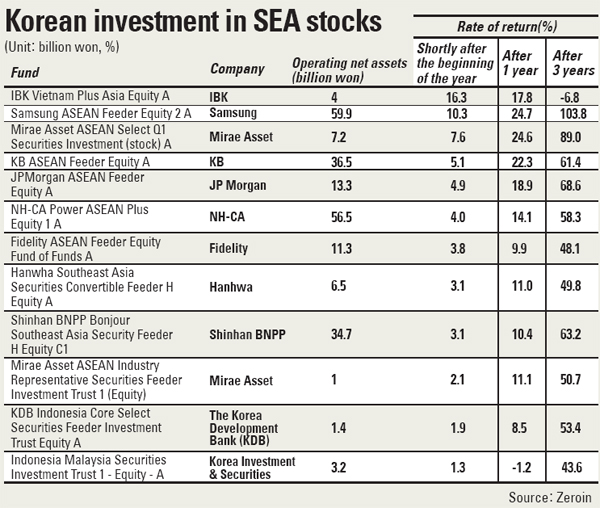Southeast Asian markets are on a roll

Veitnam’s Ho Chi Minh Stock Index soared 19.4 percent, while Indonesia’s Jakarta Composite Index (JKSE) rose 14.3 percent.
Only Malaysia, in which Vanguard Group disposes of shares like in Korea, saw its stock index fall 3.6 percent.
Funds that also invest in Southeast Asia have also skyrocketed.

The rate of return of IBK Asset Management’s Vietnam Plus Asia Fund reached 16.3 percent and that of Samsung Asset Management’s ASEAN fund was 10.3 percent.
Even looking at three-year returns, most funds are recording performances of more than 40 percent.
Geared by the good performances, Southeast Asia funds drew 18.8 billion won ($17.4million), while the overseas equity funds withdrew almost 576 billion won.
Foreigners are also paying attention to Southeast Asia. According to Shinyoung Securities, foreigners boosted stock prices through net buying of Indonesia shares worth?$ 1.027 billion from the beginning of this year through last Tuesday.
Bullish Southeast Asian stocks are based on robust economic growth of the countries in the region.
The International Monetary Fund (IMF) projected that the economies of Malaysia, Vietnam, Indonesia, Thailand and the Philippines will grow by an average of 5.5 percent this year. China at 8.2 percent and India at 5.9 percent are next.
Increasing domestic consumption is the main factor that backs up their economic growth.
In recent years, global companies have moved their production bases from China to Southeast Asia where labor costs are cheaper.
Japanese firms, especially, that have bad relations with China due to the conflict over Diaoyudao, or Senkaku Island, are turning away from China to Southeast Asia.
Thanks to these foreign companies, income and consumption in these regions are expanding.
Last year, 2.71 million cars were sold in Indonesia, Thailand and Philippines, up 48 percent from the previous year.
Sales of Lotte Mart, which entered Indonesia, surged 23.5 percent last year from 2011.
“As the wage is rising and the population of main consumer class aged 20 to 44 is continuously increasing in Southeast Asia, consumption expansion and the consequent high growth will continue for the time being,” said Lee Seung-joon, researcher at Hi Investment & Securities.
However, some industry observers point out that the Southeast Asian stocks rose too steeply, meaning that the investment risk also went up.
“The current price-earnings ratio (PER) of the South East Asian Stock Market is 13 times, lower than the historical average of 14.4 times,” said Kim Sung-joon, senior analyst at Samsung Asset Management. It means that there is room for rising even higher.
The PER is calculated by dividing the current market price per share of the stock by earnings per share. It indicates that the higher the number is, the overrated the stock is.
“In order for the PER in this region to become 14.4 times, the stock index should rise more than 12 percent,” Kim added.
There are domestic stocks that will benefit from the expanding consumption in Southeast Asia.
By Kwon Hyuk-joo [kjy@joongang.co.kr]










with the Korea JoongAng Daily
To write comments, please log in to one of the accounts.
Standards Board Policy (0/250자)